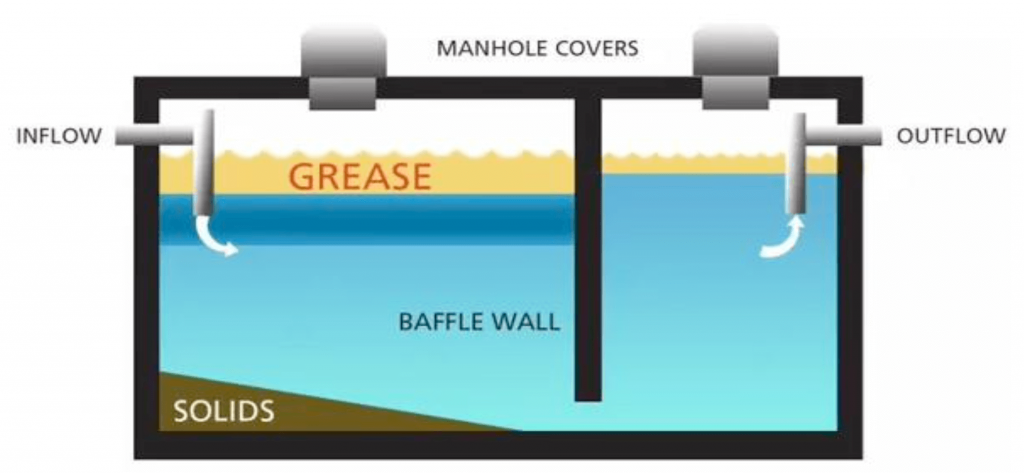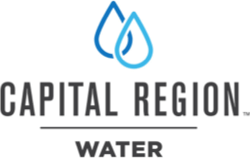Capital Region Water is implementing a Fats, Oils, and Grease (FOG) Program to combat the growing problem of grease in our sewer pipes. As grease builds on pipe walls, it constricts the pipe’s capacity and, ultimately, causes overflows in kitchens, basements, and streets.
Why Is Grease a Problem?
Large amounts of oil and grease cause trouble in system pipes by decreasing pipe capacity. This means that piping systems need cleaned more often, or even replaced sooner than expected. Oil and grease also hamper effective treatment at the wastewater treatment plant. Concerns caused by waste generated by food service facilities have served as the basis for ordinances and regulations governing the discharge of grease material into the wastewater collection system. This type of waste has forced the requirement for the installation of grease control devices, commonly known as grease traps or interceptors.
Restaurant and Commercial Responsibility
Restaurant owners, managers, and employees are in a special position to help fight the battle against grease. Below is useful information and best management practices that can be used to significantly reduce the amount of grease in our sewers.
What Is a Grease Trap?
A grease trap, Figure 1, is a device that is installed inside the building or under the sink to separate and retain grease and solid materials from the waste stream while allowing the balance of the liquid waste to discharge to the wastewater collection system by gravity. Baffles in the grease trap retain the wastewater long enough for the grease to congeal and raise to the surface. Traps have a removable lid on the top surface to facilitate inspection and cleaning.

Figure 1: A grease trap is installed inside the building or under the sink to separate and retain grease and solid materials from the waste stream.
What Is a Grease Interceptor?
The purpose of a grease interceptor, Figure 2, is to catch and collect fats, oils, and grease from commercial and restaurant kitchens. As wastewater flows through a kitchen’s plumbing (three-compartment sinks, prep sinks, mop sinks, dishwashers, floor drains, etc.) into a grease interceptor, the fats, oils, and grease are intercepted or filtered out in a large underground holding tank. The capacity of the interceptor provides adequate residence time so that the wastewater has time to cool, allowing any grease time to congeal and rise to the surface where it will accumulate until the interceptor is cleaned. Once the grease interceptor reaches maximum capacity, a certified grease trap cleaning company will need to be called in order to service the grease interceptor. Failure to service a grease interceptor on a routine and timely basis can result in complete backup of the kitchen’s plumbing system. This can result in kitchen shutdown and foul odors.

What Is a “FOG Disposal System?”
FOG (fat, oil, and grease) disposal systems are engineered alternatives to traps and interceptors. They are designed to remove grease from wastewater to acceptable levels.
For best practices and further information about proper disposal, refer to our FOG program documents.
Homeowners and Residential Responsibility
There are several steps you can take to prevent sewer backups for yourself and your neighbors.
Can Your Grease
Liquid cooking grease, oils, and fats harden when poured into a sink drain. As they harden, they clog sewer pipes and cause sewage to back up into your basement. Apartment buildings are even more vulnerable to backups caused by grease because of multiple kitchens draining to a single pipe.
How to can your grease:
- Take leftover grease and pour it into an empty container with a lid.
- Let the container with the grease or oil cool. You can place the container in the refrigerator for future use, if it’s not full.
- While you wait for the container to cool, use a paper towel to wipe away any remaining grease or oil on your pots or pans. You can toss this paper towel in the trash when you’re finished.
- Once the grease cools and turns solid, you can throw it in your trash. If it’s still liquid, make sure you close the container to prevent making a mess.
Throw Only Toilet Paper Down the Drain
Never flush anything other than toilet paper down the drain. Even wipes advertised as “flushable” can lead to backups.
If a backup occurs because of a clog in your sewer service line, you are responsible for all repair and cleanup costs.
The Benefits of Fat-Free Pipes
- Save money. It can cost thousands to hire professionals to clean up after a basement backup.
- Less hassle. No basement backups means no property damage, no smelly basement, and no hassle.
- Happier neighbors. Grease can cause backups in sewer mains, which can cause backups for every house on your street.
- Healthier environment. Less grease in the pipes also prevents sewage from spilling into the Susquehanna River.
Report Illicit Discharge
To report a discharge or pollutants, please complete this form or call our Customer Service Center 888-510-0606. Our office is open 8:30 a.m. to 4 p.m., Monday-Friday. Items in red must be completed to submit the form.
